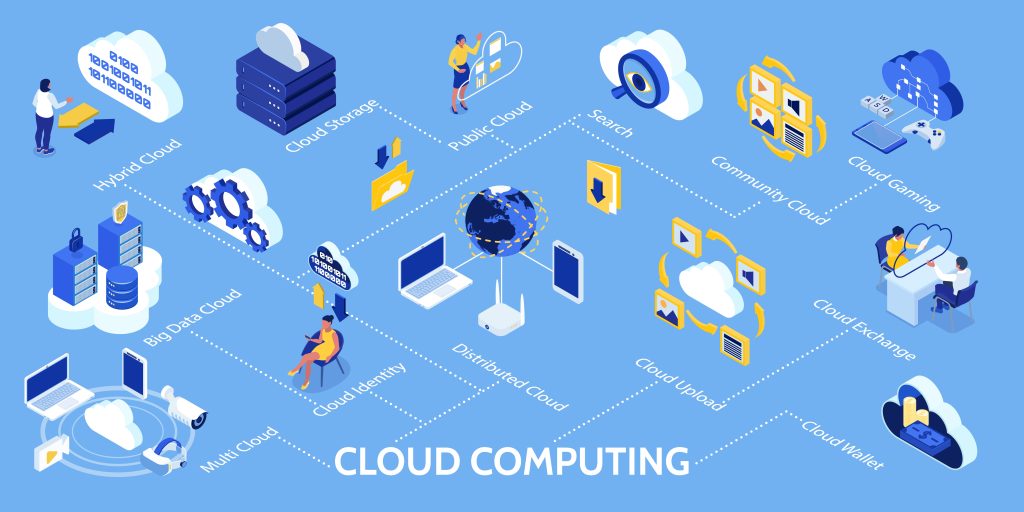In today’s digital landscape, understanding cloud computing basics is essential for anyone seeking to harness technology effectively. This comprehensive guide will break down the fundamental concepts of cloud computing, exploring its types, benefits, and practical strategies for effective use, ensuring that even beginners can grasp these crucial ideas.

What is Cloud Computing?
At its core, cloud computing refers to the delivery of computing services over the internet. These services encompass storage, processing power, and applications, all made available on-demand. Instead of relying on local servers or personal computers, users can access resources remotely, allowing for remarkable flexibility and scalability.
Types of Cloud Computing
To truly grasp understanding cloud computing basics, it’s crucial to recognize the different types of cloud services available:
- Infrastructure as a Service (IaaS): This model provides virtualized computing resources over the internet. Users can rent IT infrastructure such as servers, storage, and networking on a pay-as-you-go basis. Popular examples of IaaS include Amazon Web Services (AWS) and Google Cloud Platform (GCP).
- Platform as a Service (PaaS): PaaS offers a platform that allows developers to build, deploy, and manage applications without needing to handle the underlying infrastructure. Services like Heroku and Microsoft Azure exemplify this model, making it easier for developers to focus on writing code instead of managing servers.
- Software as a Service (SaaS): SaaS delivers software applications over the internet, eliminating the need for installation and maintenance on local devices. Users can access applications like Google Workspace and Salesforce through a web browser, ensuring seamless collaboration and accessibility.
Benefits of Cloud Computing
Understanding cloud computing basics also involves recognizing its numerous benefits, which include:
- Cost Efficiency: By leveraging cloud services, businesses can significantly reduce the costs associated with maintaining physical servers and hardware. This pay-as-you-go model allows for better financial management.
- Scalability: Cloud solutions enable organizations to scale their IT resources up or down according to demand. This is particularly beneficial for businesses with fluctuating workloads, as they can easily adjust their resources without overcommitting.
- Accessibility: Users can access cloud services from anywhere with an internet connection, fostering remote work and collaboration. This accessibility empowers teams to work together efficiently, regardless of location.
- Disaster Recovery: Many cloud providers offer data backup and recovery solutions, ensuring business continuity in the event of failures. This feature is critical for organizations that cannot afford to lose data.
Key Strategies for Utilizing Cloud Computing
To effectively leverage cloud computing, consider these essential strategies:
- Assess Your Needs: Before diving into cloud computing, assess your organization’s needs. Determine what resources and services are necessary for your operations. This evaluation will help you choose the right cloud services that fit your specific requirements.
- Choose the Right Provider: Research various cloud providers and their offerings to find one that aligns with your needs. Look for reliability, security features, and customer support. Evaluating providers will help you select one that fits your budget and technical requirements.
- Plan for Security: Implement robust security measures, such as data encryption and access controls, to protect sensitive information stored in the cloud. Security should be a top priority, especially for organizations handling confidential data.
- Monitor Usage: Regularly review your cloud usage to ensure you’re optimizing resources and managing costs effectively. Utilize analytics tools provided by cloud services to track performance and spending.
- Train Your Team: Provide training for your staff on how to use cloud tools efficiently. A well-informed team can maximize the benefits of cloud computing and improve overall productivity.
Emerging Trends in Cloud Computing
As you explore understanding cloud computing basics, it’s also essential to stay updated on emerging trends that shape the industry:
- Multi-Cloud Strategies: Many organizations are adopting multi-cloud strategies, utilizing services from multiple cloud providers to avoid vendor lock-in and enhance flexibility.
- Serverless Computing: This trend allows developers to build and run applications without managing servers, automatically scaling resources based on demand. It simplifies application deployment and reduces costs.
- Edge Computing: With the rise of IoT devices, edge computing is becoming more prevalent. It involves processing data closer to the source rather than relying solely on centralized cloud servers, improving response times and reducing latency.
Conclusion
Understanding cloud computing basics is crucial in today’s technology-driven world. By grasping the different types of cloud services, their benefits, and practical strategies for implementation, you can position yourself or your organization for success in the digital landscape. Cloud computing offers unprecedented opportunities for businesses to innovate and improve efficiency.
References
- AWS Overview: Amazon Web Services
- Google Cloud Services: Google Cloud
- Understanding IaaS, PaaS, SaaS: IBM Cloud
- Cloud Security Best Practices: NIST
- Cost Benefits of Cloud Computing: Forbes









